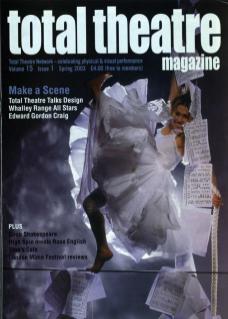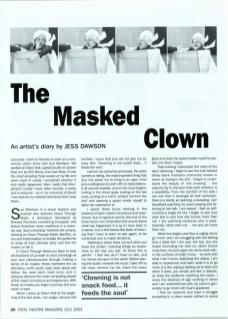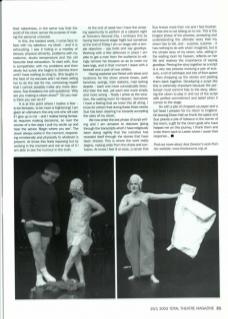Last year, I went to Toronto to work on a one-woman clown show with Sue Morrison. We worked at Clown Hall, a great studio on Queen East run by Erin Bouvy and Lisa Ross. It was the most amazing three weeks of my life and when back in Leeds I wondered whether it ever really happened. Was I really that disciplined? Luckily I have video records, a script and a costume – so in my moments of doubt I can look at my material and know that I was there...
Sue Morrison is a clown teacher and director who teaches Clown Through Mask, a technique developed by Richard Pochinko combining European and Native American clown traditions in a visionary way. Sue's directing methods are unique, drawing on Clown Through Mask, Bouffon, Le Jeu and Improvisation to enable the performer to arrive at their ultimate story and find the means to tell it.
In Clown Through Mask you learn to face all directions of yourself at once and laugh at your own ridiculousness through making a series of six masks; these represent the six directions, north, south, east, west, above and below. You wear each mask once, and in doing so discover the most compelling aspect of the mask's innocence and experience. With these six masks you begin a journey and your clown is born.
When I arrive at Clown Hall at the beginning of the first week, I am eager, nervous and terrified. I know that Sue will not give me an easy ride: ‘Clowning is not snack food... it feeds the soul.'
I set out my costumes and props, the video camera is rolling, the most important thing that Sue has asked me to bring is an open mind and a willingness to work with no expectations. It all sounds feasible, and so the ritual begins; inviting in the clown gods, putting on the red nose, putting on a hat to protect me from ‘the shit' and opening a space inside myself to allow the experience in.
I spend three hours working in the essence of each mask's innocence and experience; Sue is rigorous and by the end of the three hours I am exhausted and unsure about what has happened; it is as if I have been in a trance. It is in this trance-like state of clowning that I have to learn to see again, to be conscious and to make decisions.
‘Working in clown does not end when you leave the studio'; clowning brings an awareness to the way you see. At times this is painful – I feel raw, as if I have no skin, and my nerves are open to the world. Before leaving the studio I reverse the ritual: I take off my red nose, remove my hat, thank the clown gods and close the space inside myself to protect me when I leave.
That evening I transcribe the video of the day's clowning. I begin to see the truth behind those blank moments commonly known in clown as 'being in the shit'. I begin to understand the beauty of 'not knowing’ – the opportunity to discover that each direction is a possibility. From the comfort of the sofa I can see that in amongst all that confusion, there is a clarity, an opening, a revealing. I am transfixed watching my clown playing and listening to her talk. I am eased, I feel no self-conscious angst for her. I begin to see how wise she is and how she knows more than me. I am watching someone who is paradoxically 'other than me’ – me and yet more than me.
“Clowning is not snack food... it feeds the soul”
Week two begins and Sue is urging me to go more and I am struggling with the feeling that it feels like I am over the top, but she keeps reminding me that my clown knows more than me and urges me not to work within the confines of what I know – to work with what I don't know. Watching the videos, I am able to experience and learn what it is to go more, it is like urging a stalling car to start and when it does, you exhale and feel a release, as does the audience watching the clown. I enjoy the absence of ego working in clown and I am overwhelmed with my clown's generosity to go more with Sue's guidance.
I find my costume and have a struggle accepting it; a clown wears clothes to reveal their nakedness, in the same way that the world of the clown serves the purpose of making the personal universal.
In this, the hardest week, I come face to face with my saboteur, my block – and it is exhausting. I see it hiding in a medley of decoys: physical ailments, problems with my costume, studio temperature and the old favourite total exhaustion. To start with, Sue is sympathetic with my problems and then slowly but surely she begins to dismiss them until I have nothing to cling to. She laughs in the face of my excuses and I sit there willing her to do the rest for me, convincing myself that I cannot possibly make any more decisions. Sue threatens me with questions: 'Why are you making a clown show?' 'Do you really think you can do it?'
It is at this point where I realise a fear – to be fantastic, to be more is frightening! I am given an ultimatum: the only one who will care if I give up is me – and I realise being fantastic requires making decisions, so over the course of a few days I pull my socks up and hear the advice 'Begin where you are'. The clown always works in the moment, responding emotionally and physically to whatever is present. At times this feels exposing but by working in the moment and not on top of it am able to see the humour in the truth.
At the end of week two I have the amazing opportunity to perform at a cabaret night at Toronto's Second City. I embrace this by having bed-bound stage fright but somehow at the end of Friday I am on stage with a simple objective – say hello and say goodbye. Working with a few defences in place I am able to get a man from the audience to willingly remove his trousers so as to cover my bare legs, and in that moment I leave with a farewell and a pair of new strides.
Having explored and flirted with ideas and locations for the show: phone boxes, park benches, swings, train stations, mail sorting depots – each one more conceptually beautiful than the last, yet each one more empty and more wrong – finally I arrive at the location, the waiting room for Heaven. Somehow I have a feeling that we knew this all along, know for certain that during these three weeks Sue has been steering me towards accepting the story of my clown.
We now enter the last phase of script writing and I am amazed to discover going through the transcripts which I have religiously been doing nightly that the narrative has revealed itself through the stories that have been shared. This is where the work really begins, making order from the chaos and confusion. At times I feel ill at ease, a sense that Sue knows more than me and I feel frustrated that she is not letting on to me. This is the longest phase of the process, accepting and understanding the ultimate story that my clown has to tell, and surprise, surprise – it has nothing to do with what I imagined, but is the simple story of my clown, who, sitting in the waiting room for heaven, reflects on her life and realises the importance of saying goodbye. Piecing the story together as a script is a very raw process involving a pair of scissors, a roll of sellotape and lots of floor space – then chopping up the stories and pasting them back together. Developing a script like this is extremely important because the performer must commit fully to the story, allowing the clown to play in and out of the script with perfect commitment and belief when it comes to the stage.
So with a pile of chopped-up paper and a full head I prepare for my return to England. On leaving Clown Hall we thank the space and Sue places a pile of tobacco in the comer of the room, a gift for the clown gods who have helped me on this journey, I thank them and invite them back to Leeds where I await their response...
Find out more about Jess Dawson's work from her website: www.thedawsons.org.uk


